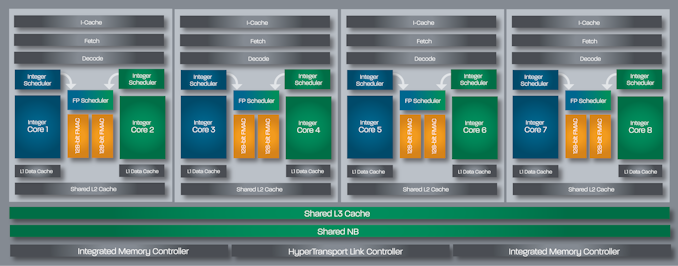AMD Bulldozer 'Core' Lawsuit: AMD Settles for $12.1m, Payouts for Some
by Anton Shilov on August 28, 2019 1:15 PM EST
AMD this month has agreed to pay compensation that totals $12.1 million to users who purchased FX-8000/9000 CPUs via its website or in the state of California. The case comes down to AMD advertising these processors as having 8 cores, and the claim that a shared FPU unit within a 'dual core' module does not constitute an actual core of performance similar to a separate core/FPU unit. Users who qualify for the compensation are estimated to recieve in the region on $35, depending on the exact uptake, and no one person can claim more than $7500.
AMD’s Bulldozer microarchitecture used 'dual-core modules' containing two independent ALUs and a shared FPU. AMD believed that such design allowed it to call its FX-8000 and FX-9000 series processors as the industry’s first eight-core desktop CPUs, yet the latter were quite often behind their quad-core rivals from Intel in terms of performance. As a result, a group of people from California filed a class action suit that accused AMD of false advertising back in 2015.
In early 2019, the Northern District Court of California sided with the plaintiffs and ruled that AMD’s FX-8120, FX-8150, FX-8320, FX-8350, FX-8370, FX-9370, and FX-9590 processors were incorrectly advertised as having eight cores. On August 23, the court published the class action settlement agreement under which AMD agreed to pay plaintiffs and the settlement class a compensation.
Under the terms of the deal, AMD has to create a $12.1 million settlement fund that will cover compensations to the end users, attorney fees, and settlement administration fees. The Class Counsel agreed to limit its petition for attorneys’ fees and reimbursement of expenses to no more than 30% of the fund, or $3.630 million, whereas the costs of settlement administration will be between $350,000 and $700,000. As a result, the pot to share between the actual purchasers of AMD’s select FX processors will be between $7.77 million and $8.12 million.
Purchasers entitled for up to $7500 total, have a confirmed purchase(s), and to have purched one of the processors while living in California or from AMD's website. It is noteworthy that people who bought AMD’s FX-8000E series CPUs with reduced power consumption are not eligible to get a reimbursement, and neither are people who purchased AMD’s six-core and quad-core FX-6000 and FX-4000 products.
It is hard to estimate how much money will each owner of AMD’s FX-8120, FX-8150, FX-8320, FX-8350, FX-8370, FX-9370, and FX-9590 processors will get, but considering the fact the settlement is limited to select CPUs and residents of California and those from AMD.com, actual sums may be quite sizeable. Should the actual value per unit be over $300, this will be subject to court approval.
AMD and the Settlement Administrator are order to crease a website at www.AMDCPUSettlement.com that should include the ability to file claim forms online. At press time, the website was offline, but it should be up shortly. We are awaiting AMD's official press release on the matter.
Update:
AMD has given an official comment on the result:
"AMD is pleased to have reached a settlement of this lawsuit. While we believe the allegations are without merit, we also believe that eliminating the distraction and settling the litigation is in our best interest."
Related Reading
- AMD's Steamroller Detailed: 3rd Generation Bulldozer Core
- The Bulldozer Review: AMD FX-8150 Tested
- The Bulldozer Aftermath: Delving Even Deeper
Sources: PACER, The Register (click through for document filing)











81 Comments
View All Comments
RedGreenBlue - Monday, September 2, 2019 - link
Amen.I actually have done a lot of experimentation with Engineering Sample Interlagos chips. Overclocking, benchmarking, and plotting IPC with different settings in all scenarios. An odd thing came about, the modules sometimes have incredible single thread performance with CMT off. It’s a tradeoff overall, but for times when single thread efficiency matters in gaming, it can be worth it. That 16 core ES chip is a gold-mine of fun for experimenters, enthusiasts and overclockers
RedGreenBlue - Monday, September 2, 2019 - link
Sad thing is, Zen makes all those aspects obsolete, except good old fashioned overclocking fun.crashtech - Wednesday, August 28, 2019 - link
It became pretty obvious from maintaining the Cinebench R11.5 thread that classifying the big FX's as 8 core CPUs would have made them look embarrassingly bad versus actual 8 core CPUs, so the category they went in became 4M/8C and 4C/8T, real world results made it pretty clear that a module does not 2 cores make. Heavily overclocked FX's could just keep up with Sandy Bridge i7's, but that was about it.KAlmquist - Thursday, August 29, 2019 - link
I can't find the thread crashtech is referring to, but I suspect that the 8 core FX processors didn't merely look embarrassingly bad versus "actual 8 core CPUs;" they actually were embarrassingly bad. If it were just a matter of AMD misrepresenting the core counts, then the 8 core FX processors would match the 8 core Intel processors on the single thread benchmark, and only be embarassingly bad on the multicore benchmark. I'm guessing that the Intel 8 core processors trounced AMD on both variants of the benchmark.Oxford Guy - Thursday, August 29, 2019 - link
1) Cinebench is a primarily floating point workload, so the 8 core Bulldozer design was already going to perform worse than an Intel 8 core — because it has less die space devoted to floating point performance.2) The developers of Cinebench are not gods. Their choices are their own.
duploxxx - Thursday, August 29, 2019 - link
What a huge pile of bullshit.Stupid lawsuit and judges. As if a "core" is a hard definition.
HT and SMT are also seen in Windows as a core/processor. It is as misleading as 2 SCU units with 1 FP.
HT and SMT are also not always able to run.
HeavyHemi - Thursday, August 29, 2019 - link
However, Dimmy, they are not sold with H/T or SMT as being physical cores. Keerist...can you even read?Xyler94 - Thursday, August 29, 2019 - link
As of Windows 8, Windows can differentiate between logical process and whatnot, but it does show up as a logical process to Windows.Windows doesn't understand differences when it's a VM, but it knows it's a VM, so it just reports what it uses.
TheUnhandledException - Thursday, August 29, 2019 - link
The short answer is there is no formal definition and that wouldn't matter anyways. Marketing and lawsuits about marketing are about consumer perception. If an average person would expect 8 cores to be 8 complete independent cores and you don't have that and sell it as that and said product underperforms 4 core competitors depsite being called "8 core" well you are going to payout in a lawsuit.NICOXIS - Thursday, August 29, 2019 - link
Well, this is just another proof that saving some silicon space in order to boost core count was the wrong choice.